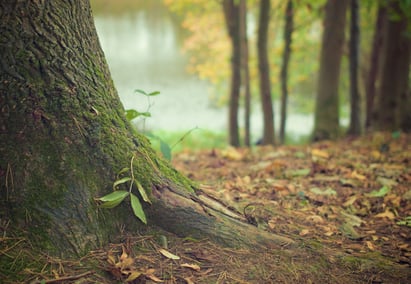Unexpected Ways Trees Can Damage Your Property
 We love trees here at Schill Grounds Management. In addition to looking majestic and providing shade, they can also be great for the environment by cleaning the air and providing us oxygen. Unfortunately, when trees are planted improperly or homes and structures are built too close to them, real damage can occur.
We love trees here at Schill Grounds Management. In addition to looking majestic and providing shade, they can also be great for the environment by cleaning the air and providing us oxygen. Unfortunately, when trees are planted improperly or homes and structures are built too close to them, real damage can occur.
Because we’re responsible for the health of thousands of trees on the properties we serve, we’ve pretty much seen it all when it comes to the damage that trees can cause. And because we’d like to prevent as much damage as possible, we wrote this article to help property managers and owners alike look be more aware of damage that trees can cause to homes, turf and other plants, and hardscapes as well as how to avoid the problem.
Damage to homes
 Although trees can technically damage any building they are too close to, we mainly see trees damaging homes on the HOA properties we manage. Very often these homes are built on what used to be wooded lots, and trees are used as boundaries between properties, but, unfortunately, when this happens sometimes not enough trees are removed and the ones that remain are too close to the home itself.
Although trees can technically damage any building they are too close to, we mainly see trees damaging homes on the HOA properties we manage. Very often these homes are built on what used to be wooded lots, and trees are used as boundaries between properties, but, unfortunately, when this happens sometimes not enough trees are removed and the ones that remain are too close to the home itself.
We also see trees that are planted too close to homes. Sometimes this happens because the homeowners buy them thinking they’re just shrubs or not knowing just how large they’ll grow. But trees that are too close to your house can cause damage to your siding, windows, roof, and gutter.
If they’re allowed to grow large enough their root systems can even cause damage to your home’s foundation. If you catch this problem early enough and the root system isn’t too developed, relocating the tree is a great, simple fix for this problem. Sadly, many homeowners wait until the damage has already been done.
Ready to find someone to help with the trees on your property?
Be sure to read our FREE Landscaping Hiring Guide first!
Damage to turf, plants, and other trees
Turf

Turf damage due to trees is another problem we typically see most of in HOA’s, but it can technically happen anywhere there are too many trees planted in an area. Densely-planted trees can keep sunlight and air from reaching the ground, which all plants need to survive, but especially super-delicate turfgrasses.
If your property has an abundance of shade due to trees, you can try planting one of the many different types of grass that are more likely to thrive in low sunlight. In addition to causing a lack of light, trees can also prevent your turf from getting the nourishment it needs from the soil.
The biggest root systems typically win out when it comes to which plants get more nutrients from the soil, so grass really can’t compete with large trees.
If you love all of your trees and can’t bear to part with even one, but still want some ground cover, you might want to consider planting some shade-loving perennials or shrubs like pachasandra, myrtle, or hosta. Plants like these tend to be heartier than turf and require less maintenance, though their growth can be difficult to control. As always, if you’re a member of an HOA, always remember to check their rules and guidelines before installing any new plants.
Damage to other plants and trees
We’ve already mentioned that trees, because of their root size, typically win in the competition of resources with turf, and flowers and shrubs don’t fare much better. In addition to hogging soil nutrients, trees can also alter the soil’s acidity. Exactly how the soil’s pH level will be affected (more or less alkaline) depends on the type of tree. If you’re thinking about planting a tree or planting around an existing tree, be sure to get the soil tested and consult a lawn care specialist about which plants will work best together.
Sometimes on retail and office properties, trees are planted far too close to each other. This is often done when the landscapes are first installed, but eventually the trees grow and mature, leading to competition with one another for sunlight, air, and soil nutrients. Ultimately, the trees that don’t get enough of these resources are often more susceptible to disease, resulting in die back.
Drainage Issues
 Poor turf growth can also be tied to drainage problems, which trees can both cause and aggravate. Again, this is because overgrown or overcrowded trees block sunlight, which helps moisture evaporate from the soil. If the ground can’t dry, grass and other plant material won’t get the air they need to thrive.
Poor turf growth can also be tied to drainage problems, which trees can both cause and aggravate. Again, this is because overgrown or overcrowded trees block sunlight, which helps moisture evaporate from the soil. If the ground can’t dry, grass and other plant material won’t get the air they need to thrive.
Drainage issues should be fixed immediately, as they can lead to diseases plants and soil instability. But installing a drain or bioswale, as is often the recommendation, could be a waste of time and money if the trees that are causing the problem are not removed or cut back.
Another culprit for tree-related drainage issues is when tree roots creep into drainage and sewer pipes. To determine whether this is happening on your property, a plumbing specialist will typically look for roots in your pipes by taking a picture of your drainage system. Often the roots can be cleared with a high-pressure hose, but sometimes they may need to be cut.
Damage to hardscapes
 Just like the roots of trees can cause damage to your home’s foundation, they can also wreak havoc on the patios, sidewalks, and driveways when they creep under concrete or stone.
Just like the roots of trees can cause damage to your home’s foundation, they can also wreak havoc on the patios, sidewalks, and driveways when they creep under concrete or stone.
This can lead to walkways that are unlevel or completely cracked. While removing the tree is sometimes the simplest solution to this problem, this issue can also be addressed by reinforcing the hardscape itself.
For example, rebar can be added to cement so that the tree roots have a harder time displacing it.
Some people’s initial reaction is to cut the tree roots that are damaging whatever structure they’re trying to protect.
Unfortunately, this can cause the tree to become infected at the site of the cut, and the disease or rot can eventually work its way back to the trunk, eventually killing the tree.
In general, it’s typically a good idea not to plant a tree too close to any hardscapes you have installed, or to design a hardscape in close proximity to a developing tree. Consult an arborist or your landscape maintenance provider to get a good idea of how large the trees on your property are likely to grow. From that, we can typically tell how large the root systems will be (though the direction roots travel is sometimes unpredictable)—Generally, a tree’s root system is roughly the same size as its canopy in diameter.
The Schill team loves to relocate trees
After inspecting your property, our team will know the exact solution to make sure all elements of your landscape work together in harmony. Whether it’s installing root shield or barriers, cutting back overgrown branches, or removing and relocating trees altogether, we’ll make sure that your property looks its best and functions well. If you have any questions or concerns about your Northeast Ohio property, please don’t hesitate to contact us for a no-obligation consultation.
Photo Credit: Trees; Drainage issues on Air Force Base; Tree in forest
You May Also Like
These Related Stories
When Should I Treat The Winter Damage To Plants On My Property?
Is Your Landscape Winterproof? 5 Steps To preventing Winter Damage
Are lawn mowers damaging my siding?
Get Email Notifications
Your Trusted, Year-Round Commercial Landscaping Partner
Whether you're looking for transformative landscaping design and maintenance or reliable snow plowing and ice removal services, the Schill team is here to help

